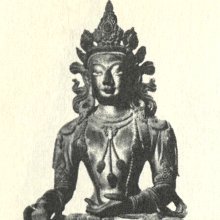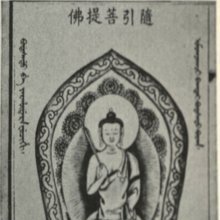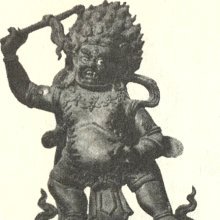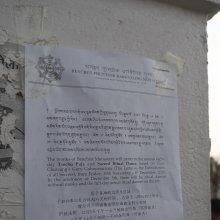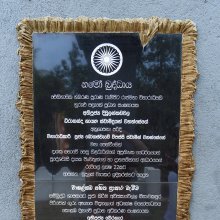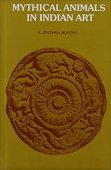Ba: 16 definitions
Introduction:
Ba means something in Buddhism, Pali, Hinduism, Sanskrit, the history of ancient India, Marathi, Jainism, Prakrit, Hindi, biology. If you want to know the exact meaning, history, etymology or English translation of this term then check out the descriptions on this page. Add your comment or reference to a book if you want to contribute to this summary article.
Images (photo gallery)
In Hinduism
Vyakarana (Sanskrit grammar)
Source: Wikisource: A dictionary of Sanskrit grammarBa (ब).—Or बकार (bakāra) the letter ब् (b), the vowel अ (a) as also the word कार (kāra) being added for facility of utterance; cf. T. Pr. I.17.21, The letter ब् (b) is sometimes used for व् (v) especially when it stands at the beginning of a word, for which scholars use the expression वबयेरभेदः (vabayerabhedaḥ).
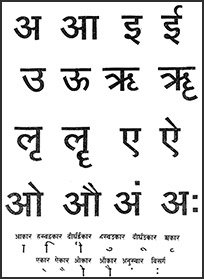
Vyakarana (व्याकरण, vyākaraṇa) refers to Sanskrit grammar and represents one of the six additional sciences (vedanga) to be studied along with the Vedas. Vyakarana concerns itself with the rules of Sanskrit grammar and linguistic analysis in order to establish the correct context of words and sentences.
In Buddhism
Tibetan Buddhism (Vajrayana or tantric Buddhism)
Source: academia.edu: A Critical Study of the Vajraḍākamahātantrarāja (II)Ba (ब) is the name of a Vākchomā (‘verbal secrect sign’) which has its meaning defined as ‘balivarda’ according to chapter 8 of the 9th-century Vajraḍākamahātantrarāja, a scripture belonging to the Buddhist Cakrasaṃvara (or Saṃvara) scriptural cycle. These Vākchomās (viz., ba) are meant for verbal communication and can be regarded as popular signs, since they can be found in the three biggest works of the Cakrasaṃvara literature.

Tibetan Buddhism includes schools such as Nyingma, Kadampa, Kagyu and Gelug. Their primary canon of literature is divided in two broad categories: The Kangyur, which consists of Buddha’s words, and the Tengyur, which includes commentaries from various sources. Esotericism and tantra techniques (vajrayāna) are collected indepently.
India history and geography
Source: Cologne Digital Sanskrit Dictionaries: Indian Epigraphical GlossaryBa.—(IE 8-1; CII 3, etc.); an abbreviation of bahula or of bahula-pakṣa, i. e. the dark fortnight; used in connection with di or ti (see ba-di, la-ti) and also by itself. Cf. va. Note: ba is defined in the “Indian epigraphical glossary” as it can be found on ancient inscriptions commonly written in Sanskrit, Prakrit or Dravidian languages.
--- OR ---
Bā.—(Bāº) (PJS), contraction of the honorific Bāi (q. v.) applied to ladies (especially in medieval Jain inscriptions of Western India). Note: bā is defined in the “Indian epigraphical glossary” as it can be found on ancient inscriptions commonly written in Sanskrit, Prakrit or Dravidian languages.

The history of India traces the identification of countries, villages, towns and other regions of India, as well as mythology, zoology, royal dynasties, rulers, tribes, local festivities and traditions and regional languages. Ancient India enjoyed religious freedom and encourages the path of Dharma, a concept common to Buddhism, Hinduism, and Jainism.
Biology (plants and animals)
Source: Google Books: CRC World Dictionary (Regional names)1) Ba in Cameroon is the name of a plant defined with Pentaclethra macrophylla in various botanical sources. This page contains potential references in Ayurveda, modern medicine, and other folk traditions or local practices It has the synonym Harpalyce macrocarpa Britton & P. Wilson.
2) Ba in Ivory Coast is also identified with Celtis mildbraedii It has the synonym see J.H. Barnhart, Biographical Notes upon Botanists. 2: 489. 1965 (etc.).
3) Ba in Papua New Guinea is also identified with Colocasia esculenta It has the synonym Caladium esculentum (L.) Vent. (etc.).
4) Ba is also identified with Erythrina variegata It has the synonym Tetradapa javanorum Osbeck (etc.).
5) Ba in Upper Volta is also identified with Bombax costatum It has the synonym Bombax vuilletii Pellegr. (etc.).
Example references for further research on medicinal uses or toxicity (see latin names for full list):
· Tableau de l’Ecole de Botanique (1829)
· Journal of Ethnopharmacology (1983)
· Acta Horticulturae Sinicae (1984)
· Bulletin of the Botanical Survey of India (1976)
· Journal of Ethnopharmacology (2001)
· Amoenitates academicae (1754)
If you are looking for specific details regarding Ba, for example side effects, diet and recipes, chemical composition, health benefits, pregnancy safety, extract dosage, have a look at these references.

This sections includes definitions from the five kingdoms of living things: Animals, Plants, Fungi, Protists and Monera. It will include both the official binomial nomenclature (scientific names usually in Latin) as well as regional spellings and variants.
Languages of India and abroad
Marathi-English dictionary
Source: DDSA: The Molesworth Marathi and English Dictionaryba (ब).—The twenty-third consonant. It corresponds with B.
--- OR ---
ba (ब) [or बई, baī].—f In nursery language. Mother, mammy, ma: also a fondling compellation for Mother in adult life.
--- OR ---
bā (बा).—m A familiar form of the word bāpa for father, Pa. 2 An affix of respect to the names of deities and men; generally causing a slight change of the word; e. g. gaṇēśa becomes gaṇōbā, vināyaka becomes vinōbā &c. 3 Applied constantly with jocose reverence; as vāghōbā, nāgōbā, vēḍōbā, dhōṇḍōbā, and others. 4 A term of endearment for a child or youth. Ex. bā tujhā cālatā kāḷa || khāyālā miḷa- tila sakaḷa ||. Pr. māgūna puḍhūna bāca navarā (First and last, Papa's the bridegroom). Used of a widower marrying again when he ought to be getting a wife for his son; and, hence, of a selfish fellow gen.
Source: DDSA: The Aryabhusan school dictionary, Marathi-Englishba (ब).—The twenty-third consonant.
--- OR ---
ba (ब) [or baī, or बई].—f Mother, mammy, ma.
--- OR ---
bā (बा).—m A familiar from of the word bāpa for father, Pa. An affix of respect to the names of deities and men; gaṇēśa becomes gaṇōbā, vināyaka becomes vinōbā &c. Pr. māgūna puḍhūna bāca (bāpaca) navarā Used of a widower marrying again when he ought to be getting a wife for his son; and, hence, of a selfish fellow.
Marathi is an Indo-European language having over 70 million native speakers people in (predominantly) Maharashtra India. Marathi, like many other Indo-Aryan languages, evolved from early forms of Prakrit, which itself is a subset of Sanskrit, one of the most ancient languages of the world.
Sanskrit dictionary
Source: DDSA: The practical Sanskrit-English dictionaryBa (ब).—
1) Name of Varuṇa.
2) Water.
3) A water-jar; (the meanings of this letter are given in the following verse; बः पुमान् वरुणे सिन्धौ भगे तोये गते तु वा । गन्धने तन्तुसंताने पुंस्येव वपने स्मृतः (baḥ pumān varuṇe sindhau bhage toye gate tu vā | gandhane tantusaṃtāne puṃsyeva vapane smṛtaḥ) || Medinī.
Derivable forms: baḥ (बः).
Source: Cologne Digital Sanskrit Dictionaries: Shabda-Sagara Sanskrit-English DictionaryBa (ब).—The twenty-third consonant of the Nagari Alphabet, corresponding to the letter B, and often confounded with the analogous semivowel va or V, with which some grammarians consider it to be at all times optionally interchangeable.
--- OR ---
Ba (ब).—m. (baḥ) 1. A name of Varuna. 2. A water jar. 3. Ocean. 4. The vulva. E. baṇ to sound, &c. aff. ḍa .
--- OR ---
Bā (बा).—Ind. 1. As, like. 2. Or, either: see vā.
Source: Cologne Digital Sanskrit Dictionaries: Monier-Williams Sanskrit-English Dictionary1) Ba (ब):—1. ba the third letter of the labial class (often confounded with va).
2) 2. ba m. = varuna
3) sindhu
4) bhaga
5) gandhana
6) vapana etc., [cf. Lexicographers, esp. such as amarasiṃha, halāyudha, hemacandra, etc.]
Source: Cologne Digital Sanskrit Dictionaries: Yates Sanskrit-English Dictionary1) Ba (ब):—ba. The 23rd consonant and third letter of the labial class.
2) (baḥ) 1. m. Varuna; a water-jar.
3) Bā (बा):—adv. As, like; or, either.
[Sanskrit to German]
Sanskrit, also spelled संस्कृतम् (saṃskṛtam), is an ancient language of India commonly seen as the grandmother of the Indo-European language family (even English!). Closely allied with Prakrit and Pali, Sanskrit is more exhaustive in both grammar and terms and has the most extensive collection of literature in the world, greatly surpassing its sister-languages Greek and Latin.
Hindi dictionary
Source: DDSA: A practical Hindi-English dictionary1) Ba (ब) [Also spelled b]:——the third letter of the fifth pentad (i.e. [pavarga]) of the Devnagri: alphabet; prefix that imparts the meaning of along with, with, for, by, from, upto, to, into, etc., e.g. [bakhūbī, bakhairiyata, barāstā].
2) Bā (बा):——a prefix to nouns meaning—having, containing, along with; (nf) mother; ~[akhalāka] well-mannered, cultured; ~[adaba] respectfully; respectful; humble; ~[asara] effective; influential; creating an impact; ~[ābarū] honourable, respectable; honourably; ~[aulāda] having a child/children; ~[ikhtiyāra] competent; authorized; ~[ijjata] honourably; respectable; ~[īmāna] honest, scrupulous; ~[kamāla] working a miracle, miraculous; wonderful; ~[kāyadā] regular(ly), formal(ly), orderly, systematic(ally); ~[kāra] employed, gainfully employed; ~[khudā] devout, God-fearing; ~[garaja] selfish, having some selfish motive; ~[jābtā] formal (ly); duly; according to rules, regular; ~[tahajība] civilised; cultured, mannerly; ~[majā] delicious, tasteful; enjoyable; ~[majāka] humorous, witty, jovial; ~[muravvata/murauvata] considerate, giving due weight to the factor of personal relationship, obliging; ~[vajā] civilized, dignified; ~[vaphā] faithful, loyal, fidel; ~[śaūra] mannerly; possessing proper manners; ~[salīkā] systematic; mannerly; ~[hama] together, collectively, mutually.
...
Prakrit-English dictionary
Source: DDSA: Paia-sadda-mahannavo; a comprehensive Prakrit Hindi dictionaryBā (बा) in the Prakrit language is related to the Sanskrit words: Dvā, Dvi.
Prakrit is an ancient language closely associated with both Pali and Sanskrit. Jain literature is often composed in this language or sub-dialects, such as the Agamas and their commentaries which are written in Ardhamagadhi and Maharashtri Prakrit. The earliest extant texts can be dated to as early as the 4th century BCE although core portions might be older.
Kannada-English dictionary
Source: Alar: Kannada-English corpusBa (ಬ):—
1) [noun] (gen. pronounced with the vowel 'ಅ') the thirty seventh letter of Kannaḍa alphabet and the twenty third consonant.
2) [noun] (math.) a symbol for the number three.
--- OR ---
Bā (ಬಾ):—
1) [verb] to extend beyond or above the normal or surrounding level (as a part of the body as a result of disease or injury); to swell.
2) [verb] to be or become filled (with pride, indignation, self-importance, etc.); to swell; to elate.
3) [verb] ಬಾತುಕೊಳ್ಳು [batukollu] bātukoḷḷu = ಬಾ [ba].
Kannada is a Dravidian language (as opposed to the Indo-European language family) mainly spoken in the southwestern region of India.
See also (Relevant definitions)
Starts with (+9980): Ba aror, Ba bao, Ba daaju, Ba daaju leo, Ba daaju nam, Ba dan xing ren, Ba dau, Ba dau la bong, Ba dau tau, Ba de, Ba dia madibou, Ba dia madibu, Ba dou, Ba du bu wae, Ba gaj c thuoosc, Ba gajc aasn dooj, Ba gajc hoa dor, Ba gajc vofng, Ba gwariya, Ba ji tian.
Ends with (+2767): A rga i rtsa ba, A rgai rtsa ba, A-gbo-loba, A-oualba, A-thongbothigba, Aababa, Aagba, Aagwa aakalaaba, Aakaaba, Aamba, Aamba, Aaragba, Aba, Ababa, Abadaba, Abahaba, Abaiba, Abajaba, Abalaba, Abarema jupunba.
Full-text (+1510): Kshiba, Ekopa, Vacapa, Dandabaladhi, Bam, Vithoba, Avantaram, Kurava, Advayu, Bahulagriva, Aharbandhava, Pheramoba(ba)dala, Anadinava, Candrabala, Vibahu, Iya, Cikkira, Arkabandhava, Pitabaluka, Alapana.
Relevant text
One of your search terms exceeds the minimun character amount per search term. This amount currently equals 2.
No search results for Ba, Bā, Bā°; (plurals include: Bā°s) in any book or story.
Related products
